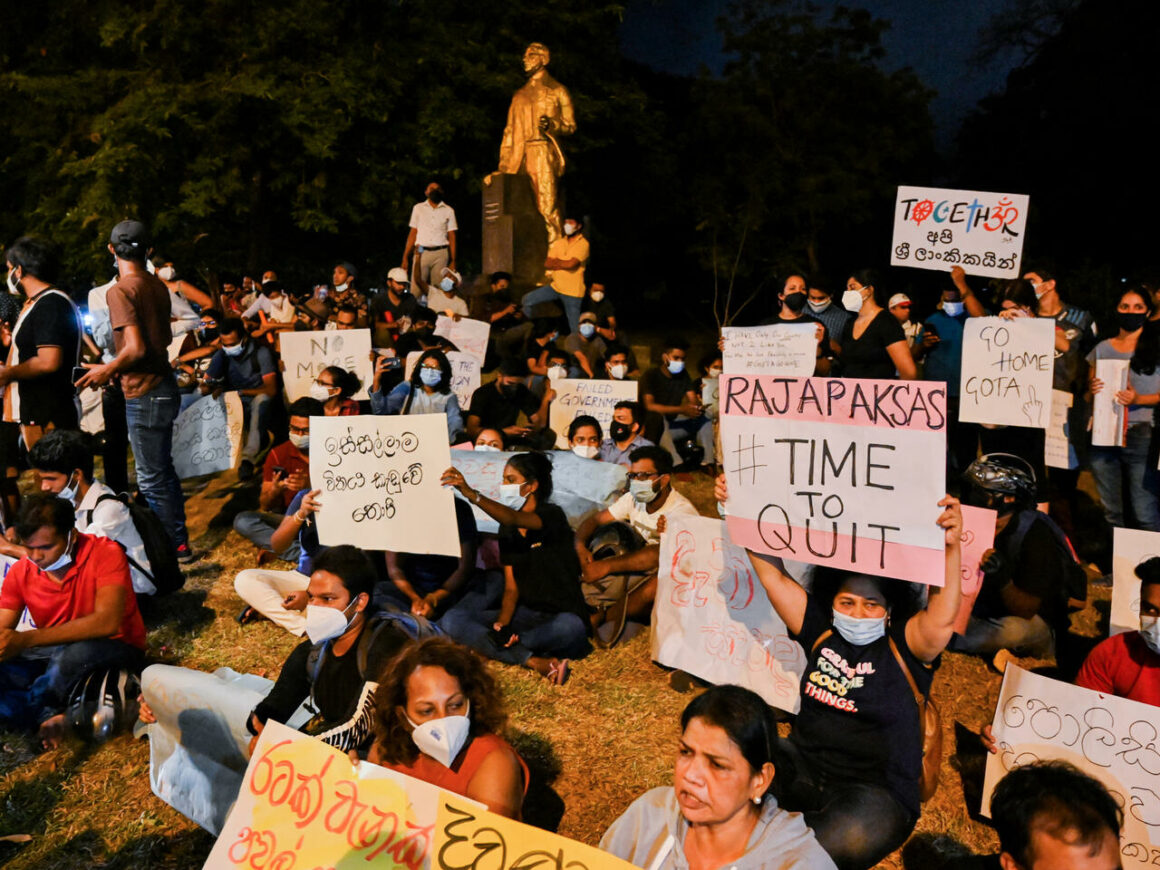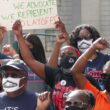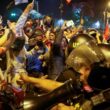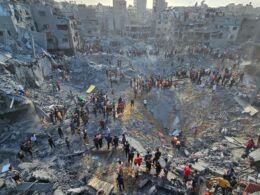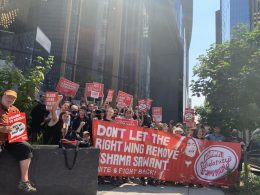By Geert Cool, Left Socialist Party (our sister organisation in Belgium)
In late 2019 and in 2020, the Rajapaksa family scored convincing victories in both presidential and parliamentary elections in Sri Lanka. As we explained then, this was a call for stability, something that the alliance around the Rajapaksa family, however, could not possibly offer. It certainly cannot do so in the worst crisis since independence in 1948. Sri Lanka has fallen into a “perfect storm” of mutually reinforcing crises, linked to this global ‘age of disorder’.
A government reshuffle will not suffice
The growing protests against the impact of the crisis on the majority of the population led to the fall of the government on April 3. President Gotabaya Rapaksa and Prime Minister Mahinda Rajapaksa were the only ones left, the rest resigned. Among the resigning ministers were also some members of the Rajapaksa family: Basil, Chamal and Namal, Mahinda’s son.
Criticism of the policy emerged from within the regime, including the blockading of social media and the declaration of a state of emergency. This indicates divisions within the ruling elite. However, if Gotabaya and Mahinda hope that a government reshuffle can stop the protest, they are mistaken. The anger is directed particularly against the president and his family, who are seen as responsible for the situation the country finds itself in. The established opposition parties have so far refused the proposal of a government of national unity, not least because they themselves have no answer to the crisis in the country.
The Sri Lankan masses are trapped in a downward spiral driven by high government debts, including to China as part of the ‘Belt and Road’ Initiative, a sharp drop in revenue, including from the decline in tourism due to the pandemic and the war in Ukraine, and the resulting skyrocketing inflation, partly linked to the worldwide increase of food prices. Foreign reserves melted away like snow in the sun, making it more difficult to import goods. A devaluation of the currency increased pressure on the living standards of the working class.
Shortages and inflation caused power cuts, unaffordable basic goods, or simply no available basic goods at all. For fuel, people sometimes stood in line for days. If fuel was available at all, prices had at least doubled. A lot of basic products are rationed, for example only 400 grams of powdered milk per person can be bought in the stores. Other products are completely absent. For example, students could not take exams due to a shortage of paper.
This context of deprivation and insecurity is the fuel for the spontaneous protests of the last few days and the growing resentment against the Rajapaksa family.
The protests are very spontaneous with hundreds of people out on the streets. There was an attempted storming of President Gotabaya’s residence near Colombo. Opposition parties are trying to get a handle on the protests. Sajith Premadasa’s Samagi Jana Balawegaya (“United People’s Power”, mainly around the old rightwing United National Party) seems to be having some impact, despite a clear lack of alternative. At the same time, it is clear that an artificial change at the top of the political establishment will not be enough to stop the protests against terrible living conditions.
In order to build these protests into a successful movement for change, it will be necessary to organize democratically in the neighborhoods and in the workplaces. In doing so, the question of an alternative to the capitalist system will have to be discussed. After all, the terrible situation for the masses today is the result of a “perfect cocktail” of capitalism.
Perfect Cocktail: Debt, falling incomes, inflation
A huge mountain of debt has built up in recent years, partly due to the cost of the civil war that ended in 2009 with a terrible massacre in which tens of thousands of Tamils lost their lives. The government at the time, also under the Rajapaksa clan, tried to maintain popular support based on loans and by attracting Chinese infrastructure projects. It hoped to become a “free haven” of trade and services in the globalized world economy. Of those hopes, little remains today. The effects of the global crisis, the process of deglobalization and the new cold war leave the Sri Lanka establishment with debts and disillusionment and the majority of the people with misery.
For the Chinese regime, a presence in Sri Lanka was of particular interest: the island is very strategically located and every step ahead of regional rival and American ally India was a bonus. For the Sri Lankan government, on the other hand, the result was a further increase in its mountain of debt. China currently accounts for about 10% of Sri Lankan foreign debt, according to government figures. This undermines the argument that China’s Belt and Road initiative is aimed at developing “partner countries” and not at China building imperialist power.
When Sri Lanka could not repay the loan to build the port of Hambantota, also the electoral base of the Rajapaksa family for many years, it had to hand over the port to a Chinese company for 99 years. Also the megalomaniac project of Colombo Port City, a new district to be raised in the sea off Colombo, which would have particularly favorable tax rates, is being pursued in cooperation with Chinese companies. Currently, the Sri Lankan government is desperately looking for Indian and other investors to prevent this project, too, from becoming entirely Chinese and, in practice, a piece of Chinese territory in front of Colombo. Already about half of the 269-hectare Colombo Port City has been bought by a Chinese government company for a lease of 99 years.
There is not only the problem of debt, but also that of declining revenues. There was the tax cut that Rajapaksa implemented in 2019, which was mainly aimed at businesses. Tourism plays an important role in the Sri Lankan economy. In 2019, there was already a downturn after terrorist violence. On top of that in 2020 came the pandemic that caused a complete collapse of the sector that still accounted for more than 12% of GDP in 2018. Just when a return of mass tourism seemed to be a possibility, the war in Ukraine came. The share of Russian and Ukrainian tourists in Sri Lanka had been increasing for several years. The power cuts, shortages and social unrest today will further complicate the return of tourism.
Inflation in Sri Lanka is running particularly high. In March it stood at 18.7% year-on-year, a further increase from February’s 15.1% and the highest inflation rate since October 2008. For food, inflation was 30.2% in March. There are fuel shortages and the threat of food shortages could lead to “hunger riots”. The shortages are exacerbated by both the lack of foreign currency for imports and the devaluation of the currency and rising food prices worldwide. The war in Ukraine, a major grain producer, and the decoupling of world economies also plays a role in those rising prices.
Desperately looking for life support
The ruling clique of the Rajapaksa family has been desperately seeking additional credit for some time. There were meetings with government representatives from India and China. In addition, new loans from the IMF are hoped for.
In 2016, Sri Lanka was already in danger of bankruptcy, after which the IMF granted a loan of $1.5 billion. This was accompanied by strict conditions, such as higher VAT rates. This year, Sri Lanka must refinance $7 billion in foreign debt. Since December, the country’s financial situation has been problematic and “creative” solutions were sought. For example, an agreement was reached with Iran to pay off an oil debt with monthly deliveries of tea.
Both India and China opened new lines of credit, but far from enough to get the country out of trouble. Negotiations with the IMF are due to start this week, but the switching of finance minister in Sri Lanka may again cause some delay.
Meanwhile, it is clear that it is impossible to pay off foreign debts and import essential goods at the same time. Without the cancellation of foreign debts, there is really no way out. Any deal with the IMF will result in additional conditions at the expense of the Sri Lankan people.
Socialist alternative needed
If the standard of living in Sri Lanka was higher than in most countries in the region in recent decades, it was the result of a stronger labor movement in the country. This was how a lot of democratic rights and social gains were enforced. In recent years, however, the labor movement has barely played a role. This was reinforced by the years of civil war and by the “euphoria” over the victory of the Sinhalese chauvinists in 2009.
The established politicians will not provide an answer to this crisis, which is determined on all sides by the contradictions and problems of world capitalism. The official opposition stands for more of the same policies, ultimately begging for money abroad at the expense of the people’s living standards. The Sri Lankan working class and poor peasants must take matters into their own hands and break with capitalism. They will not be able to do this alone; international solidarity is essential.
Previous “hunger riots” that led to revolutionary movements showed the importance of working class organization, as well as an alternative to the capitalist system of misery for the masses. The wave of revolutionary uprisings in North Africa and the Middle East over a decade ago holds many lessons for movements today. These relate to both the fact that a well-organized mass movement can overthrow dictators, “elected” or otherwise, and the fact that counter-revolution can come back to the fore if the revolution does not follow through with systemic change.
The protests must be organized in the workplaces with democratic action committees that discuss upcoming actions, coordinate regionally and nationally, and discuss a platform of demands that starts from non-payment of debts, public control of foreign trade, nationalization under workers control of the main companies and sectors, and a call for international solidarity of the working class. A complete break with capitalism is necessary to allow democratic planning of the economy and socialist transformation.





